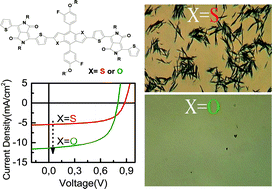Modulating molecular aggregation by facile heteroatom substitution of diketopyrrolopyrrole based small molecules for efficient organic solar cells†
Abstract
In conjugated polymers and small molecules of organic solar cells, aggregation induced by intermolecular interactions governs the performance of photovoltaics. However, little attention has been paid to the connection between molecular structure and aggregation within solar cells based on soluble small molecules. Here we demonstrate modulation of intermolecular aggregation of two synthesized molecules through heteroatom substitution to develop an understanding of the role of aggregation in conjugated molecules. Molecule 1 (M1) based on 2-ethylhexyloxy-benzene substituted benzo[1,2-b:4,5-b′]dithiophene (BDTP) and diketopyrrolopyrrole (DPP) displays strong aggregation in commonly used organic solvents, which is reduced in molecule 2 (M2) by facile oxygen atom substitution on the BDTP unit confirmed by absorption spectroscopy and optical microscopy, while it successfully maintains molecular planarity and favorable charge transport characteristics. Solar cells based on M2 exhibit more than double the photocurrent of devices based on M1 and yield a power conversion efficiency of 5.5%. A systematic investigation of molecular conformation, optoelectronic properties, molecular packing and crystallinity as well as film morphology reveals structure dependent aggregation responsible for the performance difference between the two conjugated molecules.


 Please wait while we load your content...
Please wait while we load your content...